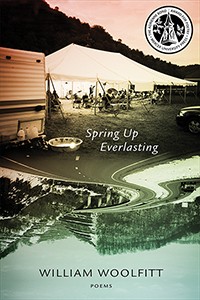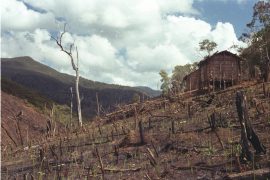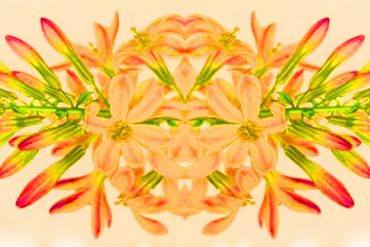William Woolfitt’s third book of poems, Spring Up Everlasting, revels in the overlapping mysteries of spirit and language, nature and nature’s degradation. Recipient of the Adrienne Bond Award for Poetry by Mercer University Press, this book believes in the Christology of the natural world, and of the humans that inhabit it. It grapples with what it means to find God in nature, when so much of nature has been blighted by human activity. To read this collection is to search for the “howl of holiness,” as Woolfitt puts it, which keeps retreating further and further into the woods.
Spring Up Everlasting is concerned with the poetics of location, narrative, and natural imagery. The opening poem “Slurry Spill,” exemplifies the best of what this collection offers. An ambivalent meditation on how the coal industry affects the American South’s landscape and communities, the poem specifies that it takes place “near Inez, Kentucky,” and gives a tactile description of polluting sludge. Woolfitt catalogues the “dirty slop of mud, mercury, arsenic, / debris that’s left over after the prep plant scrubs / it’s surfeit of coal” in lines that use alliteration and monosyllabic words to mimic the thick texture of the slurry. The poem also cites the language of the affected community, pulling in quotes from unnamed locals:
The thickest chocolate shake, people say.
Smells like hydraulic. A slow-moving black
smothering. Children throw rocks at the creek,
busted cement bricks, old tires, just to find
what else will float. Around here, you don’t
have to be Jesus to walk on water.
By specifying the location of this slurry and incorporating spoken language, Woolfitt engages the collective psyche of this community as it makes meaning of the land’s desecration. There’s tension between the child-like appositive “thickest chocolate shake” and the wraith-like shroud of “slow-moving black smothering.” Which metaphor is more appropriate, which is more accurate, and which is more beneficial? What should we make of this final image, of slurry so thick it excites the children’s curiosity, viscous enough to make of a human body a buoy — like Jesus on the water? Woolfitt sets the course for Spring Up Everlasting with these ideas: that each individual has Christological significance, and that Christ surfaces most clearly in community, in suffering, and amid degradation.
Many of these poems, like “Slurry Spill,” insist on specifying the location in which the event of poem, for lack of a better phrase, takes place. By doing so, Woolfitt asserts the necessity of grounded particulars in the search for the holy. Woolfitt transforms the old poetic aphorism — of finding the universal in the specific — into something more powerful. In these poems, Woolfitt gleans spiritual understanding through documentation. He invites us to reconsider what it means to take part in communion. Is it possible to move beyond asking for absolution, to seek identification with the body of Christ itself? How can we hope to understand our own significance without a map of our geography, without the materials we take from the earth?
Consider “The Wish to Take Sacrament Outside Red Knob Holiness Church.” As Woolfitt takes delight in such a particular, pleasurable name for a church, this poem, too, uses the space of an epigraph to name its location: “near Gate City, Virginia.” Woolfitt describes the yearning he feels during communion: “Sometimes I want to be joined, folded in, / taken into a body not my own.” He yearns not to be nourished by the bread and the wine, but to be that nourishing element, an element that he finds present in the daily repetitive ministry of an old, small church. His attention then moves from the sacrament to the people that administer it:
Sister Gladys plugs in
the coffee pot, heats water to mix
with the chilly well-water
pumped outside, water like I imagine
God’s spirit to be—clear, moving, free,
silver-bright in the deeps—
while Sister Myrtle arranges towels washed
a hundred times, wrung out, dried
on clotheslines, sun-faded
and raveling, coming undone.
He honors by name Sister Gladys and Sister Myrtle who do the humble work of revitalizing their local, spiritual community. Woolfitt ends the poem with this image of threadbare towels moving closer, through overuse and exposure, to the unbounded state of spirit.
Woolfitt is at his strongest when he describes spiritual encounters in the American South. His vision, however, extends to stories and experiences abroad, documented with the same reverence for physicality and destruction. In “Forever Prisoner,” a detainee at Guantanamo Bay sculpts a ship out of cardboard and a prayer cap. This poem ends, “his rag-sails are ballooning with wind,” an image that I take to mean: he is still filled with the same spirit, reminiscent of St. Paul during his imprisonment. In “The Great Auks of Funk Island,” another title reveling in the pleasure of names, naturalists in Newfoundland discover a “jackpot” cache of bird bones. In “Travels in Mali,” a visitor yearns to “add what he can give / to the fury and the fray,” transformed by the landscape and ritual drumming of his hosts. Woolfitt continues to find meaning (and what else do we mean when we say “God?”) with lived experience, the here-and-now world, and the witnessing of life as it decays.
In the tradition of poets like William Carlos Williams and James Wright, Woolfitt crafts many of his poems to end with a haunting, revelatory image. While not lacking similes and metaphors, the clear, precise descriptions in these poems direct the reader to the holiness of the physical world as it is — not as it could be understood in figurative language. In “Self-Portrait on the Blackwater Trail,” Woolfitt expresses the wish to, like a squirrel, “feed on lichens, leap from spruce crown / leap like I was made for it, and then glide.” In “The Pine Barrens,” he notices a sapsucker facilitating the renewal of the forest: “His skin prickles, flushes, blooms. / The cones ooze resin, open, and drop their seeds.” The ending of “Brush Arbor,” phrases this tendency as a kind of ars poetica: “Say it plain, I tell myself. That in the hollows / in the gaps, you believe.” Here, Woolfitt comes closest to describing his poetics in his own words.
The final, eponymous poem in Spring Up Everlasting reads with special significance for me. I grew up in a conservative, evangelical family that took the task of discerning “right theology” overly seriously. Reading this poem reminded me of the conversations I had in the fourth grade with my dad concerning the theologically correct way to baptize someone. Should a Christian be baptized as an infant or after a profession of faith? Should it be done by immersion or sprinkling? Woolfitt ends his collection with this imperative:
Warn us when the hour comes
for a bubbling-up, a brimming-
over of cistern, or basement,
or stream, that we may bring
buckets, canning jars, our leaky
hands, and fill them with some pitch,
some slurry, and turn back the tarry
waters rising at our feet.
These lines recall the impending slurry from the book’s opener. Woolfitt recasts baptism (at least, I am primed to read baptism into these water-logged stanzas) not as a theological conviction, but as something that happens in experiencing the cycles of the earth. It shows me that the act of choosing your own baptism is a luxury and privilege. I had the luxury of arguing over the best way to signify transfiguration, while the communities Woolfitt describes undergo change out of necessity and in order to survive. I write this in my apartment nearly two months into Virginia’s stay-at-home orders. How prescient, this idea that baptismal transfiguration comes for us with dangers. Like the floods in this poem, the pandemic threatens the lives and livelihood of our communities, and it requires both preparation and cooperation.



